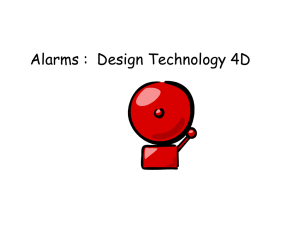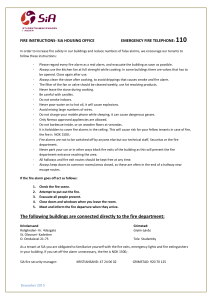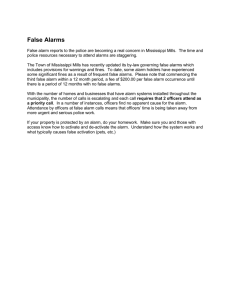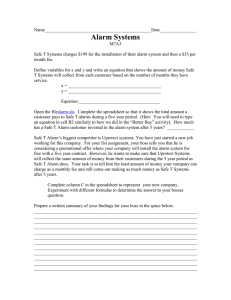Wake Up! From Alarm Fatigue
advertisement
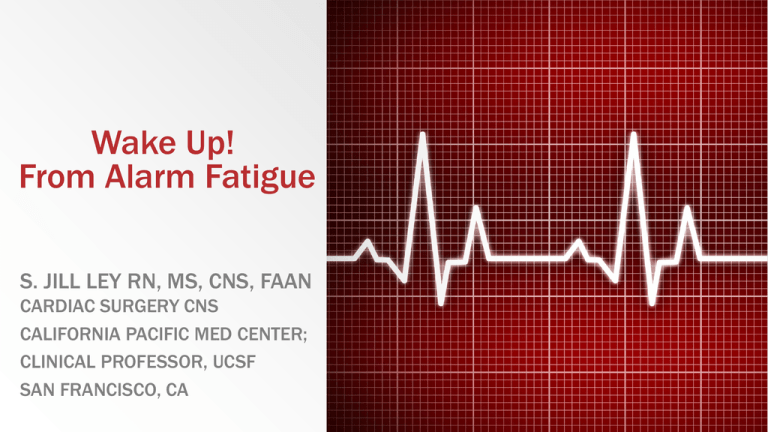
Wake Up! From Alarm Fatigue S. JILL LEY RN, MS, CNS, FAAN CARDIAC SURGERY CNS CALIFORNIA PACIFIC MED CENTER; CLINICAL PROFESSOR, UCSF SAN FRANCISCO, CA Objectives ▪ Define the concept of “alarm fatigue” and factors that contribute to it’s occurrence ▪ Discuss a comprehensive clinical alarm assessment, policy and educational strategy that improve alarm safety while meeting regulatory requirements ▪ Identify essential provisions and timelines for implementation of The Joint Commission’s National Patient Safety Goal for alarm management Responding to Alarms Alarm sounds . . . . . . ▪ Hear the alarm ▪ Determine meaning/interpret ▪ Prioritize if immediate action necessary ▪ Distinguish what action is appropriate ▪ Respond ▪ Patient care – resuscitation response, notifications ▪ Adjust monitor parameters/fix equipment How Do Alarms Work? ▪ Current Designs ▪ High sensitivity – detect even minute changes = frequent alarms ▪ Low specificity – do not distinguish if real or important = frequent alarms ▪ Threshold Technology ▪ Each alarm has a threshold that must be breached for it to sound (e.g., low HR at 50 bpm) ▪ Each alarm as a separate threshold (HR vs SBP vs SpO2) ▪ Thresholds may not be integrated (e.g., asystole alarm & A-line BP 110/72) ▪ Built in delays for “self correction” prior to alarm are possible ▪ Current Options to Reduce Alarms Include ▪ Disabling the parameter ▪ Changing the threshold ▪ Increasing the delay The Problem With Alarms ▪ Ranked as #1 top technology safety hazard by ECRI (Economic Cycle Research Institute) ▪ 86% - 99% of alarms are non-actionable ▪ Fire alarms work because they are a RARE event! ▪ When the same alarm sounds for a life threatening arrhythmia versus brushing your teeth, then “Nothing is an Emergency” Question #1 A non-actionable alarm can be caused by all of the following except: a) b) c) d) Artifact Self-correcting SpO2 Leads off Narrow alarm limits Question #1 A non-actionable alarm can be caused by all of the following except: a) b) c) d) Artifact Self-correcting SpO2 Leads off Narrow alarm limits Alarm Fatigue Terminology Actionable Alarm – Requires intervention ▪ to reverse or prevent patient deterioration ▪ to maintain appropriate monitoring, avoid missing critical events Non-actionable [nuisance] alarm – Does not require intervention ▪ True: alarm was accurate but unimportant ▪ False: alarm error (e.g., artifact) Number of Alarms Baseline Alarm Assessment – 4 Units, 1 Campus, ONE Day > 5000 Alarms/Day! 2000 1800 1600 1400 1200 1000 800 600 400 200 24 patients 16 patients 8 patients 0 YELLOW BED RED BED YELLOW ARRHYTHMIA RED ARRHYTHMIA 4S 177 60 1534 56 TICU 422 125 444 9 12 patients MSICU 437 25 661 36 Most common Yellow arrhythmias: Pair PVCs, PVC rate > 10/min, multiform PVCs CCU 344 42 531 2 Internal Alarm Frequency Audit Strategy 3 campuses, 11 units 9,515 alarms/day ▪ Set up “event groups” at each central station (once then save groups) ▪ Event group = red arrhythmia, yellow arrhythmias (3), discharge (hi/lo HR), all alarms ▪ Patient window → all controls → unit settings → event groups → new group/name ▪ Review and collect individual patient data ▪ Patient window → alarm review → event review → select 24 hrs → select event group ▪ Tally by unit Hallmark Alarm Study ▪ High surveillance monitoring; 5 critical care units, 461 patients, 31-days ▪ Total number of alarms 2,558,760 ▪ Arrhythmia alarms 1,154,201 ▪ Parameter alarms 612,927 ▪ Technological 791,632 ▪ Audible alarms 381,560 Audible alarms per patient bed per day = 187! Drew BJ, et al. PLoS ONE 9(10): e110274. doi:10.1371/journal.pone.0110274 Accuracy of ECG Arrhythmia Alarms Drew BJ, et al. PLoS ONE 9(10): e110274. doi:10.1371/journal.pone.0110274 SBAR Plan For ECG Monitoring Situation = too many alarms that don’t mean anything Background = things were different when I trained Assessment = we have to do something! Recommendation = Alarm Makeover California Pacific Medical Center - Alarm Management Plan ▪ Review detailed data from all units, formulate multidisciplinary approach RN, MD, biomed, admin ▪ Begin with evidence-based monitor changes: add high priority/RED alarm for leads off ▪ Incorporate changes in nursing practice and culture through unitbased Alarm Champions Form Alarm Fatigue Task Force Use Data to Plan Approach Phase I: Monitor Settings Agreement Evaluate Approvals Changes Phase II: Change Clinical Practice Nurse Champions Evaluate Culture & Protocols Changes Alarm Fatigue Task Force ▪ Funding by CPMC Foundation Grant ▪ Team Leaders ▪ Jill Ley & Robert Airoso ▪ Physician Champion: Rick Hongo, MD ▪ Biomed Champion: Dale Rose ▪ Nurse Champions: ▪ ▪ ▪ ▪ ▪ ▪ ▪ ▪ ▪ Flor Aguilar, Telemetry St Lukes Danielle Burian, ICU Davies Josie Buangan, St Lukes Caitlin Carpenter, 6-south Pacific Linda Chu, TICU3, Pacific Eva DeLeon, St Lukes Jeanne Ebuen, 4-south, Pacific Julie Esposto, 4-south Pacific Al Flores, ICU Davies ▪ Nurse Champions (con’t): Elizabeth Foley, 4-south Pacific Aaron Fong, 6-south Pacific Mina Jackson, TICU Pacific Wen Bei Jiang, MSICU, Pacific Rasheda Jones, Education St Lukes Mary Kazeminejad, 4-south, Pacific Marvin Lai, St Lukes Kayline Martinez, CCU Pacific Barbara Morales, CCU Pacific Shelly Petrie, 5-south Pacific Hieu Pham, MSICU Pacific Tonya Rozen, 5-south Pacific Lauren Shinjo, CCU Pacific Ann Soy, 5-south Pacific Sasha Sunder, TICU3 Pacific Ron Villanueva, St Lukes Question #2 Evidence based resources regarding alarm management include: a) b) c) d) AACN Clinical Toolkit for managing alarm fatigue A Joint Commission National Patient Safety Goal ERCI alarm safety resource center All of the above Question #2 Evidence based resources regarding alarm management include: a) b) c) d) AACN Clinical Toolkit for managing alarm fatigue A Joint Commission National Patient Safety Goal ERCI alarm safety resource center All of the above Evidence-Based Monitoring Standards ICU Drill Down: Yellow Arrhythmia Alarm by Type Redundant Alarms Recommendation: Implement Johns-Hopkins Best Practices Remove “Nonactionable” Yellow Alarms PREDICTED 65% REDUCTION eliminating: PVC pairs and runs, Multiform PVCs, Bi- and Tri-geminy Additional change – leads off now a high priority alarm Standardize HR defaults to 135, 50 and SpO2 88% Also eliminate redundant alarms Additional A Fib Alarm Changing the Culture of Nursing Practice: Phase II Implementation ▪ NEW: Electrode skin prep and change frequency increased to q 24 hrs TRUE ▪ Alarm settings now reviewed at handoff ▪ Adjust HR within 5-20 bpm from default as appropriate to pt condition ▪ Disable irregular HR alarm for All of these were false chronic AF (no order required) ▪ Enable paced rhythm alarm for paced patients (no order required) ▪ Proactive “pause” for leads off ▪ Assume any alarm is now “actionable” FALSE DUE TO ARTIFACT 21% 79% Eliminate false alarms due to artifact Results: Yellow Alarms/Patient Day Reduced 57-89% By Unit # alarms/pt/day 200 180 160 140 120 100 80 60 40 20 0 77% 80% 57% 59% 60% 82% 85% 85% 88% 86% 89% Before After Press-Ganey Patient Satisfaction Scores for Noise Continued Improvement on Pilot Unit Satisfaction Level Project Implementation Additional Solutions: Criteria for Telemetry Do we NEED to monitor everyone? Potential Adverse Consequences of ECG Monitoring ▪ Alarm fatigue! ▪ Resource utilization ▪ Nursing hours and ratios ▪ Disposables ▪ Equipment maintenance and upkeep ▪ Reduced mobility for the patient ▪ Increased time in bed ▪ Potential delirium, PNA, etc. ▪ Patient & family concerns of being “critically ill” ▪ Misinterpretation of artifact as VT Artifact Mimicking Ventricular Tachycardia FROM: Knight BP, et al. NEJM 1999; 341(17):1270-1274. This patient was treated with lidocaine Drew showed that 86.8% of VT alarms are FALSE! Evidence Based Criteria for Telemetry Monitoring ▪ Class I – Indicated for nearly all acute patients ▪ Potential for ischemia (ACS, high risk CAD) ▪ Potential for arrhythmia (post arrest, drug load, > Mobitz II heart block, etc) ▪ Procedural or critically ill (postop heart, PCI, conscious sedation, etc) ▪ Class II – Indicated for some patients ▪ Potential for instability (chest pain, syncope, hypotension, etc) ▪ Class III = Monitoring is not indicated ▪ Acute conditions (low risk surgery, terminal illness, atypical chest pain, etc) ▪ Chronic, stable conditions (atrial fib, asymptomatic PVCs or NSVT, etc) Henriques-Forsythe MN, Ivonye CC, Jamched U, et al. CCJM. 2009;76(6):368-372. Drew BJ, Califf RM, Funk M, et al. Circulation 2004;110:2721-2746. Re-audit 1 year later: Yellow Alarms/Patient Day By Unit # alarms/pt/day 70 60 50 Baseline 2014 2015 40 30 20 10 0 CCU - PAC TICU - PAC 5-south MSICU 4-south TICU-3 6-south Audit Observations ▪ Excellent compliance with setting alarm parameters ▪ Customizing to patient ▪ Enabling/disabling alarms for pacers/Afib ▪ Maximum # alarms/patient/day fell from 349 to 173 ▪ Reasons for high alarm frequency ▪ Patient with intermittent paced rhythm ▪ Bundle branch blocks ▪ Artifact ▪ Fewer patients on monitor despite similar census Question #3 The Joint Commission National Patient Safety Goal for alarm safety requires organizations to do all of the following by January 1, 2016 except: a) b) c) d) Establish alarm safety as an organizational priority Complete a detailed inventory of all audible alarms in the facility Determine who can change or disable clinical alarms Determine appropriate responses to alarm conditions Question #3 The Joint Commission National Patient Safety Goal for alarm safety requires organizations to do all of the following by January 1, 2016 except: a) b) c) d) Establish alarm safety as an organizational priority Complete a detailed inventory of all audible alarms in the facility Determine who can change or disable clinical alarms Determine appropriate responses to alarm conditions Getting Ready for The Alarm Safety National Patient Safety Goal NPSG.06.01.01: Improve the safety of clinical alarm systems ▪ Phase 1 – Effective January 1, 2014 ▪ Establish alarm safety as an organizational priority and determine YOUR facility’s most important alarms to manage ▪ Gather data – internal alarm history, adverse events (labor intensive but essential) ▪ Review and compare with best practices/guidelines ▪ Determine a plan for reducing unnecessary alarms ▪ Phase 2 – Effective January 1, 2016 ▪ Establish policies & procedures for alarm management ▪ Staff educated about appropriate practices This is not just for ECG alarms! Warming Devices Foot Pumps SpO2 Monitors Infusion Pumps Bed Alarms Hemodynamics Ventilators/CPAP Alarm Management Policies and Procedures ▪ Should address the following areas: ▪ ▪ ▪ ▪ ▪ ▪ ▪ ▪ ▪ Clinically appropriate alarm settings When alarms can be disabled When alarms can be changed Who can disable alarms Who can set alarm parameters Who can change alarm parameters Appropriate monitoring practices Appropriate response to monitor alarms Processes for checking alarms for accurate settings, appropriate operation, and detectability (audibility throughout unit) Coming Soon System-Wide Alarm Policy POLICY AND PURPOSE Alarm management is a Joint Commission National Patient Safety Goal (NPSG.06.01.01) that this organization has identified as a priority. Clinical alarm systems are intended to alert caregivers to an important change in the patient's physiologic condition or a medical device equipment issue and, if not managed properly, can compromise patient safety. Alarm Priority Levels Risk/Priority Criteria Response Time Level of Oversight High • • Potentially life-threatening, audible alarms Inattention could result in permanent harm or death Immediate Goal <2 minutes Need for close observation of patient and device all or most of time* Moderate • Not life-threatening, medium priority, audible warning Non-emergent; requires attention as quickly as possible Rapid Goal 2-5 minutes Need for close observation of patient and device many times throughout shift No harm to patient if evaluated within short time period Audible advisory signal indicates need for reassessment As soon as possible Goal 5-7 minutes No need for intervention throughout shift anticipated or patient harm if unattended • Low • • Modified from policy graciously provided by Johns Hopkins Medical Center Staff Responsibilities For Alarm Safety ▪ Critical clinical alarm systems will not be disabled. Patient care staff will check all equipment with clinical alarms to ensure: ▪ ▪ ▪ ▪ Settings are appropriate for each patient; Alarm is active; Alarm is not impaired in any manner; Alarm is sufficiently audible to all staff with respect to distance and competing noise ▪ Caregivers and equipment users will verify, as appropriate, that critical alarms are in the "On" position and sufficiently audible: ▪ ▪ ▪ ▪ Prior to using the device on a patient; When assuming care of a patient (i.e., at the start of shift); Following removal and subsequent reapplication of the device on a patient; Prior to transferring a patient with the device to another care area. Alarm Fatigue Summary ▪ Alarm management is an important problem that creates safety risks, leading to a new national patient safety goal ▪ Use of internal alarm data is essential to target highest priority alarms and improve outcomes ▪ Implementation of evidence-based practices is effective in reducing nuisance alarms while improving safety ▪ The Joint Commission NPSG will require us to do more in 2015 and beyond to address this issue

